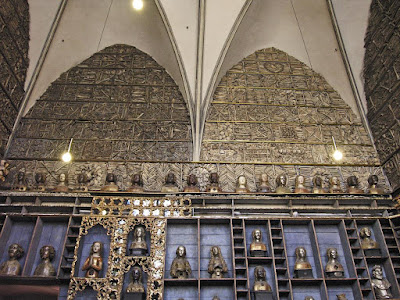Basilicas in Germany—Greater Cologne
Basilica of St. Gereon, Cologne, North Rhine-Westphalia
Declared a minor basilica by Pope Benedict XV in 1920.
The Romanesque church was completed in 1227 and incorporates a Roman wall. There is evidence that a church was on this site as early as the 7th Century honoring Gereon, a Roman soldier who was martyred for the Faith.
The first two pictures are from local sources, the third is from Pinterest, and the last from Wikipedia.
Basilica of St. Ursula, Cologne, North Rhine-Westphalia
Declared a minor basilica by Pope Benedict XV in 1920.
St. Ursula was a 4th Century virgin who had traveled to Cologne with 11 (or possibly 11,000) other virgins for her wedding to a local prince. The Huns attacked their party and all were martyred for the Faith. The basilica was built on the site of a Roman cemetery—construction began in the early 12th Century and was completed in the 13th Century. The building is primarily Romanesque with a Gothic choir. Baroque elements were added in 17th Century. Ursula’s remains and those or her companions are kept in The Golden Chamber within the church. The Church was heavily damaged in the Second World War but has been restored.
All pictures are from Wikipedia.
Basilica of St. Severin, Cologne, North Rhine-Westphalia
Declared a minor basilica by Pope Pius XII in 1953.
The Basilica is dedicated to St. Severin who served as the third Bishop of Cologne in the 4th Century. A church has been on this site since the 4th Century. Parts of the church date to the 9th Century and it was renovated and enlarged until the 16th Century. The Romanesque church was badly damaged during the Second World War but has been restored.
All pictures are from Wikipedia.
Minster Basilica of St. Martin, Bonn, North Rhine-Westphalia
Declared a minor basilica by Pope Pius XII in 1956.
An abbey was established at this site in the 7th Century and this church was built as an abbey church in the 11th Century. It became the parish of St. Martin in the 19th Century. It was primarily built in a Romanesque style, but there are also Gothic and Baroque elements. The church has been badly damaged on more than one occasion but has been restored including as recently as 2021.
The top picture is from Alamy and the last two are from Wikipedia.
Pictures with sources
Basilica of St. Mary in the Capitol, Cologne, North Rhine-Westphalia
Declared a minor basilica by Pope Paul VI in 1965.
The Basilica is the largest Romanesque Catholic church in Cologne and is considered the most important after the Cathedral. It was built in the 11th Century on the site of a Roman temple (hence the name Capitol). One of the Basilica’s features is an 11th Century wooden door which has 26 relief depictions from the life of Jesus.
All pictures are from Wikipedia.
Basilica of the Holy Apostles, Cologne, North Rhine-Westphalia
Declared a minor basilica by Pope Paul VI in 1965.
The Romanesque church dates to the 11th Century but was mostly reconstructed in the 13th Century. It was damaged during the Second World War but has been restored. There are statues of all of the Fourteen Holy Helpers most dating to the 16th Century. The Basilica also has a 13th Century chalice.
All pictures are from Wikipedia.
Basilica of St. Andrew and St. Mary Magdalene, Dormagen-Knechtsteden, North Rhine-Westphalia
Declared a minor basilica by Pope Paul VI in 1974.
A Romanesque church was built on this site in the 12th Century as part of a Premonstratensian abbey. It was destroyed by war in the 15th Century and rebuilt in a Baroque style in the 18th Century. Napoleon closed the abbey in the 19th Century and much of it burned down in 1869. The abbey and the church were rebuilt in 1908 for the Spiritan Order—about 20 Spiritans currently live there. The current church is more Gothic and Romanesque and features 12th Century frescoes that somehow survived wars and fires.
All pictures are from Wikipedia.
Basilica of St. Kunibert, Cologne, North Rhine-Westphalia
Declared a minor basilica by Pope John Paul II in 1998.
Kunibert was a 7th Century Bishop of Cologne who built a church on this site and was buried there. The current Romanesque church was built in the 13th Century. The building was badly damaged during the Second World War, but has been restored. The original windows were stored and thus survived the War. One unique feature is a well near where legend has it, the Virgin Mary would feed porridge to children. In Cologne, tradition said that children were not brought by a stork, but rather sprang from this well.
All pictures are from Wikipedia.



































No comments:
Post a Comment